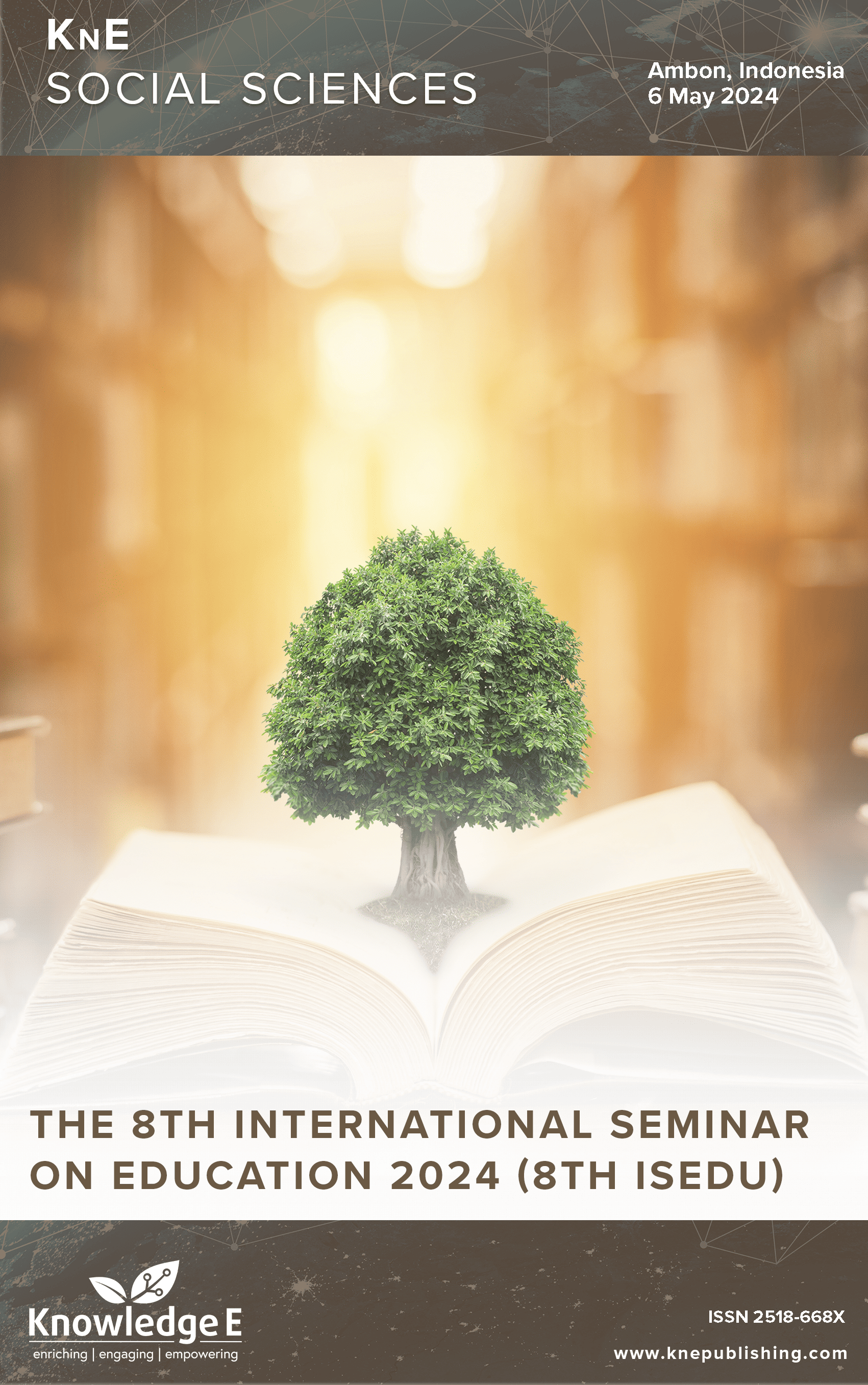Elementary School Students' Literal Thinking Ability in Solving Flat Figure Problems Seen from the Adversity Question
DOI:
https://doi.org/10.18502/kss.v9i31.17610Abstract
This research aims to analyze students' literal thinking ability in solving plane problems in terms of the adversity quotient (AQ). This type of research is quasi-experimental and involves 55 elementary school students in Central Maluku Regency, Maluku Province, Indonesia. The data obtained was analyzed using non-parametric statistical tests with the Kruskal Wallis test type. The results of the research show that there are differences in students' literal thinking abilities in solving flat - shape problems in terms of AQ. By using the Post-Hoc test, it was found that the literal thinking ability of AQ-Cb students was significantly different from AQ-Q and AQ-Cp, while AQ-Q and AQ-Cp level students had no significant difference. This difference is because AQ-Cb level students are more thorough and work harder in solving flat shape problems compared to AQ-Q and AQ-Cp level students. Students with high AQ are generally more skilled at understanding information, interpreting problems, and being able to make solutions correctly.
Keywords: lateral thinking, adversity quotient (AQ), mathematical problem solving
References
Li N, Chee Mok IA, Cao Y. The Evolution of Mathematical Thinking in Chinese Mathematics Education. Mathematics. 2019 Mar;7(3):1–18. DOI: https://doi.org/10.3390/math7030297
Yusmin E, Ahmad Yani T, Pasaribu RL, Fitriawa D. Students’ Mathematical Lateral Thinking Skills in Creative Problem-Solving. Al-Jabar. Jurnal Pendidikan Matemata. 2022 Jul;13(2):331–41. DOI: https://doi.org/10.24042/ajpm.v13i2.13231
Tabach M, & Friedlander A. Algebraic Procedures and Creative Thinking. ZDM: The International Journal on Mathematics Education. 2016 july;49(1):53–63. DOI: https://doi.org/10.1007/s11858-016-0803-y
Agustina V, Masrukan, Walid. Analysis of Mathematical Creative Thinking Ability in Terms of Self-Regulated Learning in Creative Problem Solving Learning Model with Performance Assessment. International Journal of Education and Research. 2023 may; 11(5): 31-44. DOI: https://doi.org/10.36277/defermat.v5i2.288
Fisher R. Teaching Children to Think”. London: Nelson Thornes. 2005.
Mustofa RF, Hidayah YR. The Effect of Problem-Based Learning on Lateral Thinking Skills. Int J Instr. 2020 Jan;13(1):463–74. DOI: https://doi.org/10.29333/iji.2020.13130a
Hadar LL, Tirosh M. Creative Thinking 0n Mathematics Curriculum: An Analytic Framework. Thinking Skills and Creativity. 2019 september:33. DOI: https://doi.org/10.1016/j.tsc.2019.100585
Julita J, Darhim D, Herman T. Improving Mathematical Lateral Thinking Ability Of High School Students Through Quantum Learning Based On Creative Problem Solving. J Phys Conf Ser. 2019 Oct;1315(1). DOI: https://doi.org/10.1088/1742-6596/1315/1/012061
Nur AS, Kartono, Zainri, Rohmad. The Lateral Thinking Processes in Solving Mathematical Word Problems Reviewed at Adversity Quotient and Refletive Cognitive Style. Infinity: Journal of Mathematics Eduation. 2022 september;11:223- 226. DOI: https://doi.org/10.22460/infinity.v11i2.p223-236
Chunin M, Petchprayoon C, Khongngam S. Adversity Quotient and Resiliency Predicting Career Success of Teachers in Secondary Schools. APHEIT International Journal. 2024 Apr;7(2):49–62.
Shodiq LJ, Juniati D, Susanah S. Mathematical Lateral Thinking Obstacles in Solving Geometric Problems Based on Brain Dominance. Aksioma Jurnal. 2022 Aug;11(3):2029–43. DOI: https://doi.org/10.24127/ajpm.v11i3.5671
Susilawati W. Pengaruh Pembelajaran Berbasis Tantangan Dengan Strategi Konflik Kognitif Terhadap Kemampuan Visualisasi Spasial, Berpikir Lateral, Dan Kegigihan Matematis Mahasiswa. Disertasi UPI Bandung; 2017.
Nurlaelah A, Ilyas M, Nurdin. Pengaruh Adversity Quotient Terhadap Kemampuan Pemecahan Masalah Matematis Siswa SD’. PROXIMAL: Jurnal Penelitian Matematika dan Pendidikan Matematika. 2022 sep; 4(2): 89-97. DOI: https://doi.org/10.30605/proximal.v4i2.1367
Diezmann CM. Challenging mathematically gifted primary students. Australas J Gift Educ. 2005 Jan;14(1):50–7.
Susilawati WL, Maryono I, Widiastuti T. Improvement of Mathematical Lateral Thinking Skills and Student Character through Challenge-Based Learning. Advances in Social Science, Education and Humanities Research. 2018 januari; 26:95-101. DOI: https://doi.org/10.2991/icie-18.2018.17
Stoltz PG. Adversity Quotient: Mengubah Hambatan Menjadi Peluang. (Alih Bahasa: T. Hermaya). Jakarta: Grasindo; 2020.
Amir Z, Risnawati MZ, Nurdin E, Permata Azmi EM, Andrian D. The Increasing of Math Adersity Quotient in Mathematics Cooperative Learning Through Metacognitive. Int J Instr. 2021 Sep;14(4):841–56. DOI: https://doi.org/10.29333/iji.2021.14448a
Qin L, Zhou Y, Tanu WT. The Analysis of Mathematics Adversity Quotient of Left Behind Junior High School Students in Rural Areas. Open J Soc Sci. 2019 Jan;07(10):331–42. DOI: https://doi.org/10.4236/jss.2019.710028
Aprilia ED, Khairiyah Y. Optimisme Menghadapi Persaingan Dunia Kerja dan Adversity Quotient Pada Mahasiswa. Seurune: Jurnal Psikologi Unsyiah. 2018 Jan;1(1):18–33. DOI: https://doi.org/10.24815/s-jpu.v1i1.9922
Dewantari AG, Soetjiningsih CH. Adversity Quotient dan Kecemasan Menghadapi Dunia Kerja Pada Mahasiswa Tingkat Akhir. Psikoborneo Jurnal Imiah Psikologi. 2022 Sep;10(3):629–36. DOI: https://doi.org/10.30872/psikoborneo.v10i3.8631
Sugiarti R, Nurlaili A, Febriani UF. Pengaruh Adversity Quotient Terhadap Motivasi Berprestasi Pada Siswa Cerdas Istimewa. Philanthropy Journal of Psychology. 2020;4(1):82–92. DOI: https://doi.org/10.26623/philanthropy.v4i1.2141

